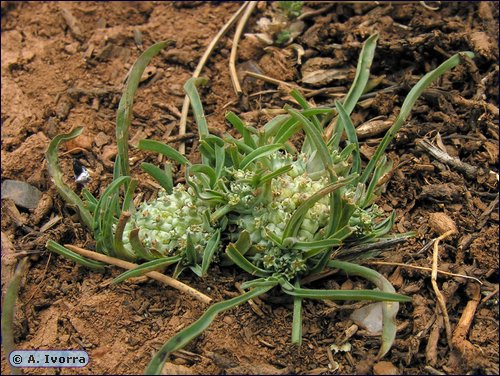Hohenackeria exscapa: Red Data Book of Armenia

EN B 1 ab(ii,iii,iv) + 2 ab(ii,iii,iv)
Category. Endangered species. It grows only in Yerevan floristic region. The area of distribution is fragmented. The extent of occurrence is less than 5000 km2, the area of occupancy is less than 500 km2. The main threats are urban development, expansion of arable lands, trampling by the cattle. It was included in the first edition of the Red Data Book of Armenia under Category 2: Rare species. It is not included in the Annexes of CITES and that of the Bern Convention.
Description. Stemless annual plant, 5–10 cm. Leaves linear–lanceolate. Inflorescence capitulate, placed almost at root collar. Fruits 5–6 mm long, congested, obpyramidate, hardly dividing to mericarps.
Distribution. In Armenia it occurs only in Yerevan floristic region (surroundings of Yerevan, villages Kosh, Udjan, Vedi). EOO is 600 km2, AOO is 40 km2, the number of locations is 3. Besides Armenia it grows in Nakhichevan, East Transcaucasia, countries of the Mediterranean Sea Basin, South Iran, Anatolia.
Ecological, biological and phytocoenological peculiarities. Grows in lower and middle mountain belts, at the altitudes of 800–1500 meters above sea level, on clay stony slopes, in semi–deserts, steppes, on red clays of the Tertiary period. Flowering from April to May, fruiting in May.
Limiting factors. Loss/degradation of habitats caused by town building, road construction, expansion of arable lands.
Conservation actions. Part of the sub–population grows in "Erebuni" State Reserve. Necessary: monitoring of the population state, search of new habitats.
Suggestions
 The Ministry of Environment sent a letter international partners to draw their attention to the real danger of environmental disasters as a result of Azerbaijan's large-scale aggression towards the territory of Armenia
The Ministry of Environment sent a letter international partners to draw their attention to the real danger of environmental disasters as a result of Azerbaijan's large-scale aggression towards the territory of Armenia
 Vicia pisiformis: Red Data Book of Armenia
Vicia pisiformis: Red Data Book of Armenia
 Vavilovia formosa: Red Data Book of Armenia
Vavilovia formosa: Red Data Book of Armenia
 Trigonella capitata: Red Data Book of Armenia
Trigonella capitata: Red Data Book of Armenia
 Trigonella astroides: Red Data Book of Armenia
Trigonella astroides: Red Data Book of Armenia












